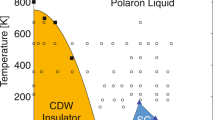Abstract
We investigate the minimal model that takes orbital degrees of freedom into account: the degenerate two-orbital Hubbard model. Our consideration includes the intraatomic Coulomb interaction of two electrons with opposite spins on the same orbital and on different orbitals and interorbital hopping of tunneling electrons. We take the influence of states caused by Hund’s rule coupling on the metal-insulator phase transition into account. We generalize the diagram theory developed for strongly correlated orbitally nondegenerate systems to the case of orbital degeneration. For the one-particle renormalized Green’s function, we establish an equation of Dyson type for calculating the system spectral function using a simple approximation based on summing chain diagrams.
Similar content being viewed by others
References
V. L. Bonch-Bruevich and S. V. Tyablikov, The Green Function Method in Statistical Mechanics [in Russian], Fizmatlit, Moscow (1961); English transl., North-Holland, Amsterdam (1962).
S. V. Tyablikov, Methods in the Quantum Theory of Magnetism [in Russian], Nauka, Moscow (1975); English transl. prev. ed., Plenum, New York (1967).
J. Hubbard, Proc. Roy. Soc. London A, 276, 238–257 (1963); 281, 401–419 (1964); 285, 542–560 (1965).
K. I. Kugel and D. I. Khomskii, Usp. Fiz. Nauk, 136, 621–664 (1982).
A. M. Oleś, Phys. Rev. B, 28, 327–339 (1983).
A. M. Oleś, M. Cuoco, and N. B. Perkins, “Magnetic and orbital ordering in cuprates and manganites,” in: Lectures on the Physics of Highly Correlated Electron Systems IV: Fourth Training Course in the Physics of Correlated Electron Systems and High-Tc Superconductors (AIP Conf. Proc., Vol. 527, F. Mancini, ed.), AIP, Melville, N. Y. (2000), pp. 226–380.
K. Kubo and D. S. Hirashima, J. Phys. Soc. Japan, 68, 2317–2325 (1999).
G. Jackeli, N. B. Perkins, and N. M. Plakida, Phys. Rev. B, 62, 372–378 (2000); arXiv:cond-mat/9910391v2 (1999).
L. Didukh, Yu. Dovhopyaty, and V. Hankevych, Phys. Rev. B, 61, 7893–7908 (2000); arXiv:cond-mat/9907037v2 (1999).
A. Koga, Y. Imai, and N. Kawakami, Phys. Rev. B, 66, 165107 (2002); arXiv:cond-mat/0206064v1 (2002).
K. Inaba, A. Koga, S. Suga, and N. Kawakami, Phys. Rev. B, 72, 085112 (2005); arXiv:cond-mat/0506150v1 (2005).
S. Cojocaru, R. Citro, and M. Marinaro, J. Phys.: Condens. Matter, 17, 1113–1126 (2005).
Y. Song and L.-J. Zou, Phys. Rev. B, 72, 085114 (2005).
K. Inaba and A. Koga, J. Phys. Soc. Japan, 76, 094712 (2007); arXiv:0706.3948v1 [cond-mat.str-el] (2007).
K. Kubo, Phys. Rev. B, 75, 224509 (2007); arXiv:cond-mat/0702624v2 (2007).
M. I. Vladimir and V. A. Moskalenko, Theor. Math. Phys., 82, 301–308 (1990).
S. I. Vakaru, M. I. Vladimir, and V. A. Moskalenko, Theor. Math. Phys., 85, 1185–1192 (1990).
N. N. Bogolyubov and V. A. Moskalenko, Theor. Math. Phys., 86, 10–19 (1991).
N. N. Bogolyubov and V. A. Moskalenko, Theor. Math. Phys., 92, 820–825 (1992).
V. A. Moskalenko, P. Entel, and D. F. Digor, Phys. Rev. B, 59, 619–635 (1999).
Yu. A. Izyumov and Yu. N. Skryabin, Statistical Mechanics of Magnetically Ordered Systems [in Russian], Nauka, Moscow (1987); English transl., Consultants Bureau, New York (1988). 1289
Author information
Authors and Affiliations
Corresponding author
Additional information
__________
Translated from Teoreticheskaya i Matematicheskaya Fizika, Vol. 168, No. 3, pp. 490–502, September, 2011.
Rights and permissions
About this article
Cite this article
Moskalenko, V.A., Dohotaru, L.A., Chebotar’, I.D. et al. The diagram theory for the degenerate two-orbital hubbard model. Theor Math Phys 168, 1278–1289 (2011). https://doi.org/10.1007/s11232-011-0105-z
Received:
Published:
Issue Date:
DOI: https://doi.org/10.1007/s11232-011-0105-z




